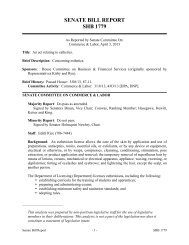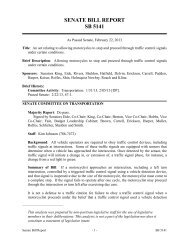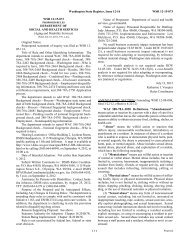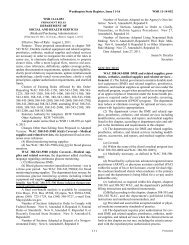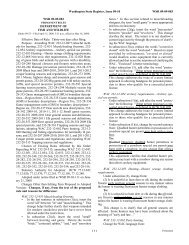Proposed
Proposed
Proposed
You also want an ePaper? Increase the reach of your titles
YUMPU automatically turns print PDFs into web optimized ePapers that Google loves.
(iii) Installing electrician's certificate number, except for<br />
telecommunication work;<br />
(iv) Job site address;<br />
(v) Contact telephone number for the job site's owner (to<br />
be used to arrange inspection); and<br />
(vi) Short description of the work.<br />
(d) The label must be filled in using sunlight and weather<br />
resistant ink.<br />
(e) The electrical/telecommunication contractor must<br />
return the contractor's portion of the label to the Department<br />
of Labor and Industries, Electrical Section, Chief Electrical<br />
Inspector, P.O. Box 44460, Olympia, WA 98504-4460<br />
within fifteen working days after the job site portion of the<br />
Class B installation label is affixed.<br />
(5))) Each entity doing work must use a separate label.<br />
(2) Before beginning the work:<br />
(a) For Class B labels obtained after February 28, 2013:<br />
(i) Immediately upon posting the Class B label/number,<br />
the purchaser must use the department's on-line Class B system<br />
to enter the job site information for an unused Class B<br />
label obtained by the purchaser. If the posting occurs on a<br />
weekend or a federal/state holiday, the purchaser must use<br />
the on-line system to enter the information no later than the<br />
first business day after posting the label/number;<br />
(ii) The person identified as the installer on the Class B<br />
label must post the Class B label or label number, in a conspicuous<br />
permanent manner, at the:<br />
(A) Main service/feeder location supplying the structure<br />
or system; or<br />
(B) Purchaser's equipment, or on the equipment conductors<br />
if the equipment is not in place.<br />
(iii) The Class B label is valid immediately upon the purchaser<br />
completing the job site information in the department's<br />
on-line Class B system.<br />
(b) For Class B labels obtained before March 1, 2013:<br />
(i) The purchaser must fully enter the job site information<br />
on the job site and contractor portions of the Class B<br />
label.<br />
(ii) The person identified as the installer on the Class B<br />
label must post the completed job site copy, in a conspicuous<br />
permanent manner, at the:<br />
(A) Main service/feeder location supplying the structure<br />
or system;<br />
(B) Purchaser's equipment, or on the conductors if the<br />
equipment is not available.<br />
(iii) The purchaser must return the contractor copy to the<br />
Department of Labor and Industries, Electrical Section, Chief<br />
Electrical Inspector, P.O. Box 44460, Olympia, WA 98504-<br />
4460 within fifteen working days after the job site portion of<br />
the Class B installation label is affixed.<br />
(iv) The Class B label is valid immediately upon posting<br />
on the job site.<br />
(3) Class B ((basic installation)) labels will be sold in<br />
blocks and are nonrefundable and nontransferable.<br />
((Installations where a)) (4) Class B ((basic installation))<br />
label ((is used)) installations will be inspected on a random<br />
basis as determined by the department.<br />
(((a) If any such random inspection fails, a subsequent<br />
label in the block must be inspected.<br />
Washington State Register, Issue 12-21 WSR 12-21-103<br />
(b) If any such subsequent installation fails inspection,<br />
another label in the block must be inspected until a label is<br />
approved without a correction(s).<br />
(c))) (5) A progress inspection fee is required for any<br />
inspection required when a correction(s) is issued as a result<br />
of the inspection of ((any)) a Class B label ((or if an inspection<br />
is required because of (a) or (b) of this subsection. See<br />
Part C of this chapter for fees)).<br />
(6) Any ((electrical/telecommunication contractor or<br />
other)) entity using the Class B ((basic electrical inspection<br />
random inspection)) process may be audited for compliance<br />
with the provisions for purchasing, inspection, reporting of<br />
installations, and any other requirement of usage.<br />
(7) ((Class B basic electrical work means work other<br />
than Class A basic electrical work. See WAC 296-46B-<br />
901(8) for Class A definition.<br />
(a))) A separate label is required for each line item listed<br />
below in subsection (10) of this section. For example, if the<br />
work includes an item under subsection (10)(a) and (b)(i) of<br />
this section, two labels are required.<br />
(8) An entity using a Class B basic inspection label is<br />
restricted to using no more than two labels per week per job<br />
site.<br />
(9) All Class B work must be completed within fifteen<br />
days after the label is validated. If the work is not completed,<br />
another Class B may be posted.<br />
Except that, in a one- or two-family residential structure,<br />
a label is valid for ninety days after the label is validated, so<br />
long as all work described on the label is performed by the<br />
purchaser.<br />
(10) Class B ((basic electrical)) work includes the following:<br />
(((i))) (a) Extension of not more than one branch electrical<br />
circuit limited to 120 volts and 20 amps each where:<br />
(((A))) (i) No cover inspection is necessary. For the purposes<br />
of this section, cover inspection does not include work<br />
covered by any surface that may be removed for inspection<br />
without damaging the surface; and<br />
(((B))) (ii) The extension does not supply more than two<br />
outlets as defined by the NEC.<br />
(((ii))) (b) Single like-in-kind replacement of:<br />
(((A) A single luminaire not exceeding 277 volts and 20<br />
amps; or<br />
(B))) (i) A motor larger than 10 horsepower; or<br />
(((C))) (ii) The internal wiring of a furnace, air conditioner,<br />
refrigeration unit or household appliance; or<br />
(((D))) (iii) An electric/gas/oil furnace not exceeding<br />
240 volts and 100 amps when the furnace is connected to an<br />
existing branch circuit. For the purposes of this section, a<br />
boiler is not a furnace; or<br />
(((E))) (iv) An individually controlled electric room<br />
heater (e.g., baseboard, wall, fan forced air, etc.), air conditioning<br />
unit, heat pump unit, or refrigeration unit not exceeding<br />
240 volts, ((30)) 40 minimum circuit amps when the unit<br />
is connected to an existing branch circuit; or<br />
(((F))) (v) Circuit modification required to install not<br />
more than five residential load control devices in a residence<br />
where installed as part of an energy conservation program<br />
sponsored by an electrical utility and where the circuit does<br />
not exceed 240 volts and ((30)) 40 amps.<br />
[ 63 ] <strong>Proposed</strong>



